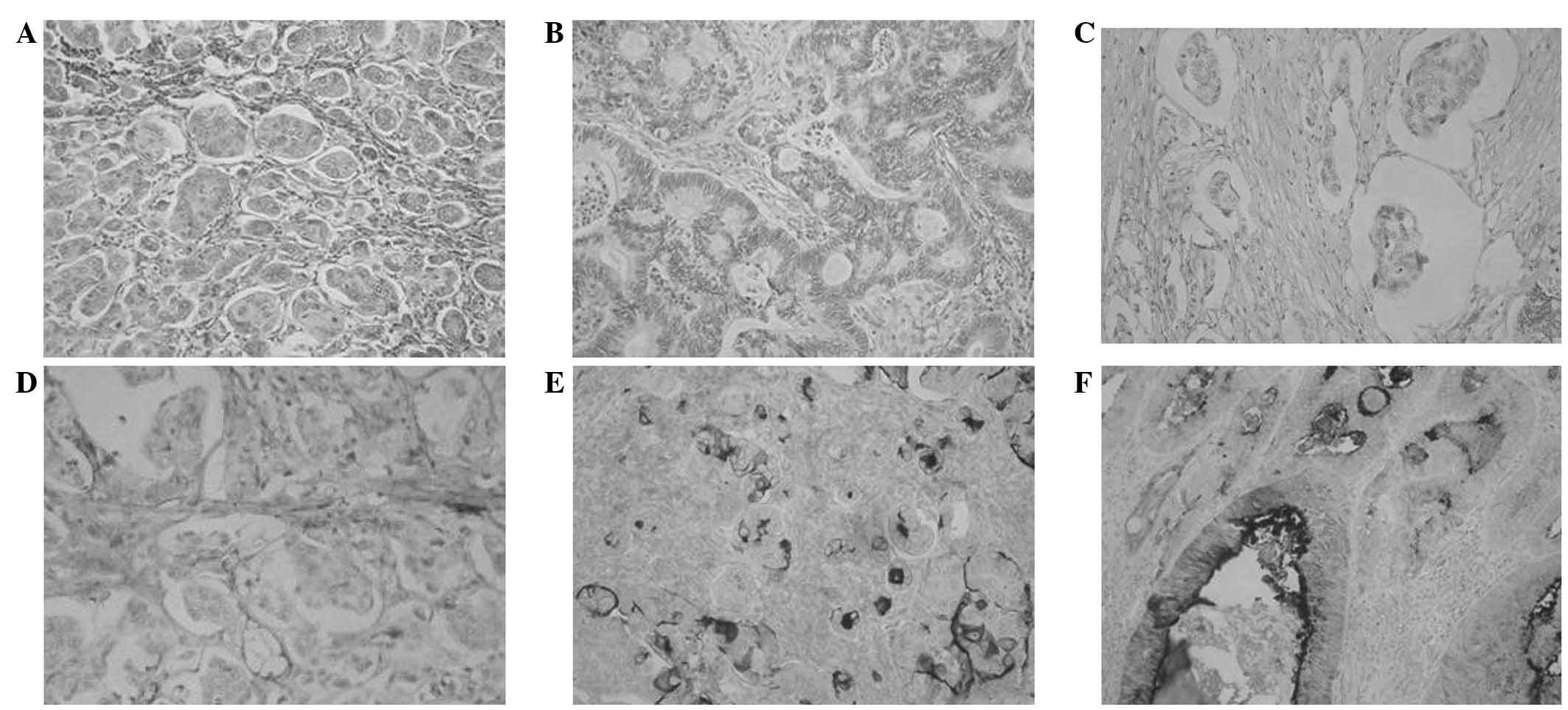|
1
|
Sonoo H, Kameyama M, Inatugi N, Nonomura A
and Enomoto Y: Pedunculated polyp of early sigmoid colon cancer
with invasive micropapillary carcinoma. Jpn J Clin Oncol.
39:523–527. 2009. View Article : Google Scholar : PubMed/NCBI
|
|
2
|
Kondo T: Colon invasive micropapillary
carcinoma arising in tubulovillous adenoma. Pol J Pathol.
59:183–185. 2008.PubMed/NCBI
|
|
3
|
Sakamoto K, Watanabe M, De La Cruz C,
Honda H, Ise H, Mitsui K, Namiki K, Mikami Y, Moriya T and Sasano
H: Primary invasive micropapillary carcinoma of the colon.
Histopathology. 47:479–484. 2005. View Article : Google Scholar : PubMed/NCBI
|
|
4
|
Ushiku T, Matsusaka K, Iwasaki Y, Tateishi
Y, Funata N, Seto Y and Fukayama M: Gastric carcinoma with invasive
micropapillary pattern and its association with lymph node
metastasis. Histopathology. 59:1081–1089. 2011. View Article : Google Scholar : PubMed/NCBI
|
|
5
|
Wen P, Xu Y, Frankel WL and Shen R:
Invasive micropapillary carcinoma of the sigmoid colon: Distinct
morphology and aggressive behavior. Int J Clin Exp Pathol.
1:457–460. 2008.PubMed/NCBI
|
|
6
|
Verdú M, Román R, Calvo M, Rodón N, García
B, González M, Vidal A and Puig X: Clinicopathological and
molecular characterization of colorectal micropapillary carcinoma.
Mod Pathol. 24:729–738. 2011. View Article : Google Scholar : PubMed/NCBI
|
|
7
|
Haupt B, Ro JY, Schwartz MR and Shen SS:
Colorectal adenocarcinoma with micropapillary pattern and its
association with lymph node metastasis. Mod Pathol. 20:729–733.
2007. View Article : Google Scholar : PubMed/NCBI
|
|
8
|
Lino-Silva LS: Pure micropapillary rectal
carcinoma with CK7 and CK20 coexpression and loss of CDX2
reactivity. Int J Morphol. 30:25–29. 2012. View Article : Google Scholar
|
|
9
|
Ohtsuki Y, Kuroda N, Yunoki S, Murakami S,
Mizukami Y, Okada Y, Iguchi M, Lee GH and Furihata M:
Immunohistochemical analysis of invasive micropapillary carcinoma
pattern in four cases of gastric cancer. Med Mol Morphol.
46:114–121. 2013. View Article : Google Scholar : PubMed/NCBI
|
|
10
|
Seidman JD and Kurman RJ:
Subclassification of serous borderline tumors of the ovary into
benign and malignant types. A clinicopathologic study of 65
advanced stage cases. Am J Surg Pathol. 20:1331–1345. 1996.
View Article : Google Scholar : PubMed/NCBI
|
|
11
|
Luna-Moré S, Gonzalez B, Acedo C, Rodrigo
I and Luna C: Invasive micropapillary carcinoma of the breast. A
new special type of invasive mammary carcinoma. Pathol Res Pract.
190:668–674. 1994. View Article : Google Scholar : PubMed/NCBI
|
|
12
|
Li YS, Kaneko M, Sakamoto DG, Takeshima Y
and Inai K: The reversed apical pattern of MUC1 expression is
characteristics of invasive micropapillary carcinoma of the breast.
Breast Cancer. 13:58–63. 2006. View Article : Google Scholar : PubMed/NCBI
|
|
13
|
Siriaunkgul S and Tavassoli FA: Invasive
micropapillary carcinoma of the breast. Mod Pathol. 6:660–662.
1993.PubMed/NCBI
|
|
14
|
Amin MB, Ro JY, el-Sharkawy T, Lee KM,
Troncoso P, Silva EG, Ordóñez NG and Ayala AG: Micropapillary
variant of transitional cell carcinoma of the urinary bladder.
Histologic pattern resembling ovarian papillary serous carcinoma.
Am J Surg Pathol. 18:1224–1232. 1994. View Article : Google Scholar : PubMed/NCBI
|
|
15
|
Amin MB, Tamboli P, Merchant SH, Ordóñez
NG, Ro J, Ayala AG and Ro JY: Micropapillary component in lung
adenocarcinoma: A distinctive histologic feature with possible
prognostic significance. Am J Surg Pathol. 26:358–364. 2002.
View Article : Google Scholar : PubMed/NCBI
|
|
16
|
Nagao T, Gaffey TA, Visscher DW, Kay PA,
Minato H, Serizawa H and Lewis JE: Invasive micropapillary salivary
duct carcinoma: A distinct histologic variant with biologic
significance. Am J Surg Pathol. 28:319–326. 2004. View Article : Google Scholar : PubMed/NCBI
|
|
17
|
Laurent I, Uzan C, Gouy S, Pautier P,
Duvillard P and Morice P: Results after conservative treatment of
serous borderline tumors of the ovary with a micropapillary
pattern. Ann Surg Oncol. 15:3561–3566. 2008. View Article : Google Scholar : PubMed/NCBI
|
|
18
|
Kuroda N, Oonishi K, Ohara M, Hirouchi T,
Mizuno K, Hayashi Y and Lee GH: Invasive micropapillary carcinoma
of the colon: An immunohistochemical study. Med Mol Morphol.
40:226–230. 2007. View Article : Google Scholar : PubMed/NCBI
|
|
19
|
Hamilton SR, Rubio CA, Vogelstein B, Sobin
LH, Kudo S, Fogt F, Riboli E, Winawer SJ, Nakamura S, Goldgar DE,
et al: Tumours of the colon and rectum: Carcinoma of the colon and
rectum. World Health Organization Classification of Tumours -
Pathology and Genetics of Tumours of the Digestive System. Hamilton
SR and Aaltonen LA: IARC Press; Lyon, France: pp. 104–110. 2000
|
|
20
|
Kim MJ, Hong SM, Jang SJ, Yu E, Kim JS,
Kim KR, Gong G and Ro JY: Invasive colorectal micropapillary
carcinoma: An aggressive variant of adenocarcinoma. Hum Pathol.
37:809–815. 2006. View Article : Google Scholar : PubMed/NCBI
|
|
21
|
Lino-Silva LS, Salcedo-Hernández RA and
Caro-Sánchez CH: Colonic micropapillary carcinoma, a recently
recognized subtype associated with histological adverse factors:
Clinicopathological analysis of 15 cases. Colorectal Dis.
14:e567–e572. 2012. View Article : Google Scholar : PubMed/NCBI
|
|
22
|
Xu F, Xu J, Lou Z, Di M, Wang F, Hu H and
Lai M: Micropapillary component in colorectal carcinoma is
associated with lymph node metastasis in T1 and T2 Stages and
decreased survival time in TNM stages I and II. Am J Surg Pathol.
33:1287–1292. 2009. View Article : Google Scholar : PubMed/NCBI
|
|
23
|
Wesseling J, van der Valk SW, Vos HL,
Sonnenberg A and Hilkens J: Episialin (MUC1) overexpression
inhibits integrin-mediated cell adhesion to extracellular matrix
components. J Cell Biol. 129:255–265. 1995. View Article : Google Scholar : PubMed/NCBI
|
|
24
|
Khayyata S, Basturk O and Adsay NV:
Invasive micropapillary carcinomas of the ampullo-pancreatobiliary
region and their association with tumor-infiltrating neutrophils.
Mod Pathol. 18:1504–1511. 2005. View Article : Google Scholar : PubMed/NCBI
|










